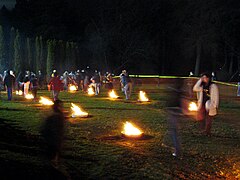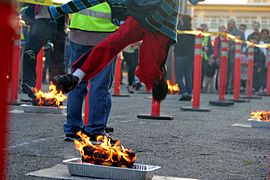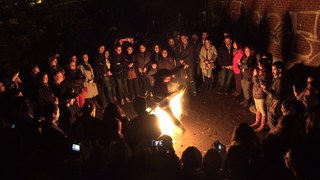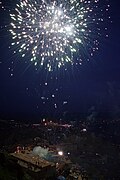Chaharshanbe Suri
| Chaharshanbe Suri | |
|---|---|
 Charshanbe Suri in Iran. | |
| Also called | Fharshanbe Soori |
| Observed by | Elsewhere by Iranian diaspora |
| Type | National, ethnic, cultural |
| Date | The last eve between Tuesday and Wednesday of the year, before the vernal equinox |
| 2024 date | 12 March |
| 2025 date | 18 March |
| 2026 date | 17 March |
| Frequency | Annual |
| Related to | Nowruz, Sizdebedar |
Chaharshanbeh Suri or Charshanbeh Suri (Persian: چهارشنبهسوری, romanized: Čahāršanbe suri;[1][2][3][4] lit. 'Scarlet Wednesday'), is an Iranian festival of the fire dance celebrated on the eve of the last Wednesday of the year, of ancient Zoroastrian origin.[2] It is the first festivity of Nowruz, the Iranian New Year.[5][6]
Etymology
[edit]The Persian name of the festival consists of čahāršanbe (چهارشنبه), the Persian word for Wednesday, and suri (سوری), which has two meanings; it may mean "festive"[2] and it may also mean "scarlet" (in traditional Persian and some current local dialects in Iran), which stems from the reddish theme of fire. The names of the festival in other languages include Azerbaijani Axır Çərşənbə (in Ardabil and Tabriz), Kurdish Kola Čowāršamba and Čowāršama Koli (in Kurdistan), Qara Chuarshanba (in Piranshahr) and Isfahani Persian Čāršambe Sorxi (in Isfahan).[2][7] The importance of fire is evident in the stone inscriptions of the Achaemenid kings, and the very first mantra of the Rig Veda is in praise of fire. Chaharshanbe Suri and Holi share roots in ancient Aryan religions.[8]
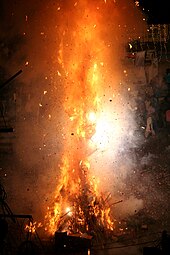
Observances
[edit]Jumping over the fire
[edit]
People collect brushwood in an open, unrestricted outdoor area prior to the festival's commencement. At sunset, after making one or more bonfires, they jump over the flames, singing sorkhi-ye to az man, zardi-ye man az to, literally meaning "[let] your redness [be] mine, my paleness yours", or a local equivalent of it. This is considered a purification practice.[2]
Spoon-banging
[edit]Charshanbe Suri includes a custom similar to trick-or-treating that is called qāšoq-zani (قاشقزنی),[9] literally translated as "spoon-banging". It is observed by people wearing disguises and going door-to-door to hit spoons against plates or bowls and receive packaged snacks.
Fortune telling (fāl)
[edit]Another popular practice on Chaharshanbe Suri is fortune telling from a jug (fāl-e kūza, fāl-e bolūnī), usually one with a wide mouth (bolūnī). Everyone present puts an ornament—a ring, bracelet, an earring—that he or she has been wearing into the jug. Then slips of paper inscribed with verses or sentences containing auguries—the number of slips must equal the number of people present—are put into the jug. A young child is assigned to reach into the jug and pull out one piece of paper and give it to the most learned or literate man in the party. Then the child pulls one of the ornaments from the jug. The man reads aloud the verse on the piece of paper, and the owner of the ornament learns from it what his or her fortune will be. In many places, including Isfahan and towns in central Iran, it is customary to take the fortunes from a copy of the dīvān of Ḥāfeẓ, rather than from pieces of paper. The reader chooses a verse at random as the fortune for the owner of the object taken from the pot. At Isfahan a small mirror and a box of collyrium, which supposedly bring good luck, are added to the ornaments in the jug (for similar customs connected with the first evening of winter, Šab-e Čella, see Enjavī, e.g., I, pp. 26, 126; II, p. 165).
Burning rue (esfand)
[edit]Burning rue seeds (Persian: اسفند, romanized: esfand; Tajik: испанд, romanized: ispand) or frankincense (kondor) at parties on the eve of Chaharshanbe Suri is a widespread practice in most regions of Persia, being considered a necessary precaution against the evil eye and malevolent spirits, devils, and genies (cf. above on fumigation to avoid the evil eye). While rue and a small amount of salt are thrown on the fire the people recite rhymes, which, though varying with the local dialects, usually go something like this: “Rue shrubs and rue seeds (esfandūne, i.e., esfand-dāna), rue shrubs with thirty-three seeds (dūne), rue shrubs know themselves; let them blast (be-tarkūne, i.e., be-tarakānad) the jealous eye” (or “the evil eye”).
Dropping the sash (šāl-andāzī)
[edit]On the eve of Chaharshanbe Suri (and also on Šab-e Čella, see, e.g., Enjavī, I, p. 25) a young man who wishes to know his chances with a particular girl fastens a rope, a sash, or a long piece of cloth to a basket and, accompanied by a member of his family, drops it through an opening or chimney of the girl’s home or drapes it from her roof or over the door. Holding one end of the rope, he hides, and when he feels a slight tug he reels in the basket to find what the head of the girl’s family has put in it (or tied to the rope); from this object he can judge whether or not the family looks on him with favor. Sometimes he puts a present for the girl in the basket—an apple, a pomegranate, an egg, or some other village product; if the girl takes his present out of the basket, it is a sign of acceptance. In some villages this ritual is performed merely as a means of fortune telling. It is popular mainly in northern regions of Iran (Azerbaijan, Āstārā, Gīlān, Zanjān, Qazvīn, Sāva, Āštīān).
Wish-granting snacks (Ajeel e Chaharshanbe Suri)
[edit]Persian tradition holds that eating a special mix of sweet and sour nuts and fruit, called Ajeel e Chaharshanbe Suri, on Chaharshanbe Suri makes wishes come true. It is a mixture of nuts and dried fruits, such as pistachios, almonds, chickpeas, and raisins.[10]
Historical background
[edit]Ancient origin
[edit]The festival has its origin in ancient Iranian rituals. The ancient Iranians celebrated the festival of Frawardigan, the last five days of the year in honor of the spirits of the dead, which is today referred to as Farvardinegan. They believed that the spirits of the dead would come for reunion. The seven holy immortals (Aməša Spənta) were honored, and were bidden a formal ritual farewell at the dawn of the New Year. The festival also coincided with festivals celebrating the creation of fire and humans. By the time of the Sasanian Empire, the festival was divided into two distinct pentads, known as the lesser and the greater panje. The belief had gradually developed that the "lesser panje" belonged to the souls of children and those who died without sin, while the "greater panje" was for all souls.
Qajar Persia
[edit]A custom once in vogue in Tehran was to seek the intercession of the so-called "Pearl Cannon" (Tup-e Morvārid) on the occasion of Chaharshanbe Suri. This heavy gun, which was cast by the foundry-man Ismāil Isfahāni in 1800, under the reign of Fath-Ali Shah of the Qajar dynasty, became the focus of many popular myths. Until the 1920s, it stood in Arg Square (میدان ارگ, Meydān-e Arg), to which the people of Tehran used to flock on the occasion of Charshanbe Suri. Spinsters and childless or unhappy wives climbed up and sat on the barrel or crawled under it, and mothers even made ill-behaved and troublesome children pass under it in the belief that doing so would cure their naughtiness. These customs died out in the 1920s, when the Pearl Cannon was moved to the Army's Officers' Club. There was also another Pearl Cannon in Tabriz. Girls and women used to fasten their dakhils, pieces of a paper or cloth inscribed with wishes and prayers, to its barrel on Charshanbe Suri.[2] In times, the cannon had been used as a sanctuary for political or non-political fugitives to be immune to arrest or to protest from family problems.[11]
Sadegh Hedayat, an Iranian writer of prose fiction and short stories, published a book, Tup-e Morvārid, in reference to the cannon that criticizes the old beliefs in Iranian folklore. The book also mentions the origin of the Pearl Cannon.
Modern era
[edit]Today, the Pearl Cannon is placed in the opening of Building Number 7 of the Ministry of Foreign Affairs at 30th Tir Avenue. The Ministry of Cultural Heritage, Handicrafts and Tourism is still in talks with the ministry to remove the gun to a museum.[12][13]
In Stockholm, Sweden, the Eldfesten annual festival is one of the largest Chaharshanbe Suri concerts and festivals in the world and is broadcast nationally on Sveriges Television and internationally on Manoto.[14][15][16]
Food of Chaharshanbe Suri
[edit]Families customarily enjoy snacks during the evening and a supper at night after the end of the festivities. The usual snacks are nuts and dried fruits (ājīl), including salted hazelnuts, pistachios, almonds, prunes, apricots, and raisins. The supper depends on available local ingredients. In Kermān and Shirāz the main dish is usually polow with pasta soup; the longer the pasta strands, the better the chances for a long life for each member of the family. In Māzandarān, Gorgān, Gīlān, and Tehran, sabzī-polow with fish is most often eaten. In Qazvīn and Garmsār sabzī-polow is made with wild herbs from the desert. In Khorasan several kinds of polow (with lentils, pasta, herbs, and vetch) are traditionally served.
Relations to other holidays
[edit]Prior to changes introduced to the Iranian calendar, Chaharshanbe Suri and the Yazidi festival Çarşema Sor overlapped in dates.[17] The two seem connected, although some Yazidi claim that the name Çarşema Sor is a recent one and the festival was celebrated under other names dedicated to the Peacock Angel.
Gallery
[edit]-
Mohammad Reza Pahlavi, the last Shah of Iran, jumping over the fire in Piranshahr, Kurdistan province.
-
Charshanbe Suri in Vancouver, March 2008.
-
Charshanbe Suri in Berkeley, California, March 2013.
-
Charshanbe Suri in New York City, March 2016.
-
2018 Charshanbe Suri fireworks in Akre.
See also
[edit]References
[edit]- ^ How To Pronounce Chaharshanbe Suri چهارشنبهسوری. How To Say, 21 March 2022.
- ^ a b c d e f Kasheff, Manouchehr; Saʿīdī Sīrjānī, ʿAlī-Akbar (December 15, 1990). "ČAHĀRŠANBA-SŪRĪ". In Yarshater, Ehsan (ed.). Encyclopædia Iranica. 6. Vol. IV. New York City: Bibliotheca Persica Press. pp. 630–634. Retrieved March 15, 2016.
- ^ Moin, Mohammad, ed. (2002) [1972]. "چهارشنبهسوری" [Č.-šanba(-e)-sūrī]. Moin Encyclopedic Dictionary (in Persian) (One-volume edition based on 6-volumes ed.). Tehran: Moeen Publications. ISBN 9789647603072.
- ^ Mosaheb, Gholamhossein, ed. (2002) [1966]. "چهارشنبهسوری" [Čahār.Šanbe suri]. The Persian Encyclopedia (in Persian). Vol. 1 (2nd ed.). Tehran: Amirkabir. p. 811. ISBN 964303044X.
- ^ Fu, Alison (March 13, 2013). "Iranian fire-jumping festival delights Berkeley residents". The Daily Californian.
- ^ Razavi, Mahboobeh (March 1, 2019). "Chaharshanbe Suri in Iran - The Festival of Fire". SURFIRAN.
- ^ Rodziewicz, A. (2016). "And the Pearl Became an Egg: The Yezidi Red Wednesday and Its Cosmogonic Background". Iran and the Caucasus. 20 (3–4): 347–367. doi:10.1163/1573384x-20160306.
- ^ Dr.Ajam (2015-03-16). "Newrouz and Chaharshanbe Suri". Parssea (in Persian and English). Archived from the original on 27 June 2020. Retrieved 2022-03-08.
- ^ American Folklife Center (1991). Folklife Center News. Vol. 13. Library of Congress. p. 6.
- ^ emily.baratzadeh (2021-03-16). "Traditions of Chaharshanbe Suri: Jumping Fire and Wish-Granting Nuts". Kitchen Starts. Retrieved 2021-03-30.
- ^ "توپ مروارید". Encyclopaedia Islamica (in Persian). Archived from the original on March 16, 2014.
- ^ "توپ مرواريد گرفتار غفلت چهارده ماهه وزارت خارجه". Iran's Cultural Heritage News Agency (in Persian). Archived from the original on May 24, 2008.
- ^ "مكاتبه براي نجات توپ مرواريداز سر گرفته مي شود". Iran's Cultural Heritage News Agency (in Persian). Archived from the original on May 24, 2008.
- ^ "SVT direktsänder Eldfesten".
- ^ "تلویزیون منوتو - تلویزیون من و تو".
- ^ Nyheter, S. V. T.; Jangali, Nicky; Derblom Jobe, Michelle (12 March 2018). "Våren firas in med eldfest i Kungsträdgården". SVT Nyheter.
- ^ Rodziewicz, Artur (March 2020). "The Yezidi Wednesday and the Music of the Spheres". Iranian Studies. 53 (1–2): 259–293. doi:10.1080/00210862.2019.1654287. ISSN 0021-0862. S2CID 211672629.


